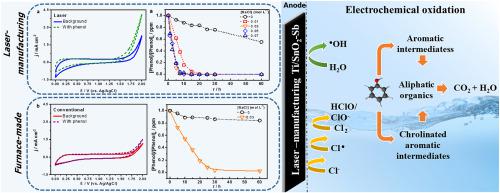Chemosphere ( IF 8.8 ) Pub Date : 2020-06-28 , DOI: 10.1016/j.chemosphere.2020.127475 Géssica O.S. Santos , Aline R. Dória , Vanessa M. Vasconcelos , Cristina Sáez , Manuel A. Rodrigo , Katlin I.B. Eguiluz , Giancarlo R. Salazar-Banda

|
In this study, a novel Ti/SnO2–Sb anode, improved using a laser heating manufacturing procedure, was applied in wastewater treatment. For comparison purposes, similar anodes were manufactured using the conventional furnace heating procedure. Electrochemical characterizations in the background electrolyte confirmed that the novel material has improved electric conductivity, as compared to the furnace-made one and, hence, it may lead to much lower operating costs in real applications. The electrocatalytic properties of the novel anode in comparison with the conventional were evaluated using a standard and well-known reaction: the phenol oxidation. Different operational conditions were evaluated. Concentrations of phenol were monitored by HPLC and analysis of organic matter by TOC analyzer. The best condition of phenol removal was associated with a relatively low energy consumption of 0.80 kWh (gTOC)−1 and specific electrical energy consumption of 0.81 kWh m−3 order−1. Interestingly, the phenol is not completely removed after 60 min of treatment using the furnace-made anode under the same operating conditions in which was fully depleted with the new electrode. Moreover, chlorinated by-products remained in the final solution with the conventional electrode and were exhausted with the novel one. Finally, after an extensive comparison with literature about the oxidation of phenol, the Ti/SnO2–Sb produced by laser-manufacturing procedure presented the best phenol removal as compared with both non-active and active anodes.
中文翻译:

使用新型激光制造的具有改善的电催化性能的Ti / SnO 2 -Sb阳极来增强废水处理能力
在这项研究中,一种新型的Ti / SnO 2–通过激光加热制造程序改进的锑阳极用于废水处理。为了比较,使用常规的炉子加热程序制造了类似的阳极。在背景电解质中的电化学特性证实,与炉法制得的材料相比,该新型材料具有更高的电导率,因此,在实际应用中可导致更低的运行成本。使用标准和众所周知的反应:苯酚氧化,评估了新型阳极与常规阳极的电催化性能。评价了不同的操作条件。通过HPLC监测苯酚的浓度,并通过TOC分析仪分析有机物。-1和0.81千瓦时特定的电能消耗中号-3顺序-1。有趣的是,在完全耗尽新电极的相同操作条件下,使用炉制阳极处理60分钟后,苯酚并未完全去除。而且,氯化副产物保留在常规电极的最终溶液中,并被新型电极耗尽。最后,在与有关苯酚氧化的文献进行了广泛的比较之后,与非活性阳极和活性阳极相比,通过激光制造程序生产的Ti / SnO 2 -Sb表现出最佳的苯酚去除率。


























 京公网安备 11010802027423号
京公网安备 11010802027423号